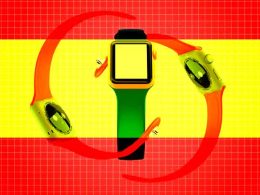Several factors contribute to this growth, including health awareness, convenience, and integration with other smart devices
The smart ring market has seen rapid expansion in 2025, driven by consumer demand for compact, efficient, and stylish wearable technology. These small yet powerful devices offer advanced health tracking, seamless connectivity, and security features, making them popular among fitness enthusiasts, professionals, and tech-savvy users. Innovations in sensor technology, artificial intelligence, and miniaturization have also contributed to market growth.
Global sales have increased significantly, with the market reaching an estimated valuation of $5.77 billion in 2025, up from $4.46 billion in 2024. Projections suggest a potential market size of $34.87 billion by 2032, as per Electroiq. Several factors contribute to this growth, including health awareness, convenience, and integration with other smart devices.
Key Drivers of Growth
1. Increasing Focus on Health and Wellness
Consumers have prioritized health monitoring, fueling demand for wearables that provide real-time health insights. Smart rings offer features like heart rate tracking, sleep analysis, and blood oxygen monitoring. These devices help users track fitness levels, detect irregularities, and optimize sleep quality.
Unlike bulky smartwatches, smart rings provide a discreet way to monitor health throughout the day. They analyze biometric data using built-in sensors and artificial intelligence, offering users actionable health recommendations. Athletes and fitness enthusiasts use these rings to track recovery metrics, stress levels, and overall well-being.
2. Advancements in Miniaturization and Sensor Technology
Technological improvements have made smart rings more functional without compromising comfort. Companies have developed ultra-thin sensors that provide accurate health readings while preserving battery life. Manufacturers have also integrated wireless charging capabilities, improving user convenience.
Artificial intelligence plays a significant role in enhancing smart ring performance. Advanced algorithms analyze collected data and generate personalized insights. Some rings now predict potential health issues based on patterns in a user’s biometric data, increasing their value as health-tracking tools.
3. Contactless Payments and Security Applications
Consumers seek faster and more secure payment options, making NFC-enabled smart rings a practical choice. These rings allow users to make transactions by tapping their finger on payment terminals, eliminating the need for physical cards or mobile wallets.
In addition to payments, smart rings enhance security by providing two-factor authentication for smartphones, laptops, and digital accounts. Some models use biometric authentication, ensuring only the registered user can access their devices or accounts. Businesses have also adopted smart rings for access control, replacing traditional keycards.
4. Fashionable and Convenient Design
Unlike smartwatches, smart rings maintain a minimalistic and stylish design. Users can wear them comfortably throughout the day without feeling burdened by weight or size. Their sleek appearance makes them suitable for both professional and casual settings.
Many brands offer customization options, allowing consumers to choose from different materials, colors, and finishes. Some models even feature interchangeable covers, catering to users who value both aesthetics and functionality.
5. Strategic Partnerships and Industry Expansion
Tech companies and health organizations have collaborated to improve smart ring technology. Some medical institutions now use smart rings for remote patient monitoring, helping doctors track vital signs and detect early symptoms of potential illnesses.
Businesses in the fitness and wellness industry have also adopted smart rings as part of subscription-based services. These rings sync with fitness apps, providing users with personalized training programs based on their biometric data.
Market Segmentation
By Technology
- Bluetooth-Enabled Smart Rings: These models connect to smartphones, allowing users to receive notifications, control music, and manage apps with simple gestures.
- NFC-Enabled Smart Rings: These rings facilitate contactless payments, digital security, and authentication, gaining popularity among professionals and frequent travelers.
By Application
- Health and Fitness: The most popular segment includes smart rings designed for heart rate monitoring, sleep tracking, and wellness analysis.
- Payments and Security: Rings that enable secure transactions and digital authentication continue to gain traction.
- Communication and Notifications: Some smart rings offer gesture-based controls for calls, messages, and smart home interactions.
Regional Insights
1. Asia-Pacific
Asia-Pacific has emerged as a dominant player in the smart ring market. Countries like China, Japan, and South Korea lead in wearable technology adoption. The increasing penetration of digital payment systems and the popularity of health-focused gadgets drive demand in this region.
2. North America
The United States and Canada account for a significant share of the market. High consumer spending, strong healthcare technology adoption, and a growing fitness-conscious population contribute to smart ring sales. Tech giants and startups continue to introduce new models, increasing competition.
3. Europe
European countries, particularly Germany, France, and the UK, have witnessed rising demand for smart rings. Many consumers prefer wearable devices that integrate seamlessly with existing smart ecosystems. Government regulations encouraging digital payments and secure authentication also support market growth.
Challenges Facing the Smart Ring Market
1. High Production Costs
Smart rings require advanced materials, miniaturized components, and high-precision manufacturing. These factors contribute to higher production costs, making premium models expensive. While demand exists, affordability remains a barrier for some consumers.
2. Battery Life Limitations
Unlike smartwatches, smart rings have limited space for large batteries. Most models require frequent charging, which may inconvenience users. Companies continue to invest in power-efficient sensors and wireless charging solutions to improve battery performance.
3. Data Privacy Concerns
Health tracking features collect sensitive biometric data, raising concerns about privacy and security. Consumers want assurances that their personal information remains protected from unauthorized access. Regulators may introduce stricter data protection policies for wearable devices.
4. Competition from Other Wearables
Smartwatches, fitness bands, and smart glasses also offer health tracking and connectivity features. While smart rings provide a unique form factor, they must continuously evolve to compete with more established wearables.
Future Outlook of the Smart Ring Market
1. Improved Battery Efficiency
Companies continue to develop low-power sensors and optimized battery designs. Future smart rings may include solar-powered charging or kinetic energy harvesting to extend battery life.
2. Integration with Medical Applications
More smart rings could receive approval for medical use, allowing doctors to monitor patients remotely. Some companies explore applications for detecting irregular heart rhythms, stress levels, and hydration levels.
3. AI-Powered Health Insights
Artificial intelligence will play a larger role in analyzing biometric data. AI-driven smart rings may provide early warnings for conditions like sleep apnea, heart disease, or chronic fatigue.
4. Expansion of Digital Payment Ecosystems
Contactless payments will continue expanding, with smart rings becoming an even more convenient option. More retailers and financial institutions will support these devices, increasing adoption.
5. Smart Home and IoT Integration
Future smart rings will connect with smart home systems, allowing users to control lights, door locks, and appliances with simple hand gestures. This integration will enhance convenience and security.
The smart ring market has grown rapidly in 2025, fueled by health-conscious consumers, technological advancements, and expanding applications. More people prefer these discreet and stylish wearables for health tracking, payments, and security. Asia-Pacific, North America, and Europe lead in adoption, with companies investing in better battery life, AI-driven insights, and medical integrations.
Challenges like production costs and data privacy concerns remain, but the industry continues to evolve. Smart rings will likely play a bigger role in personal health management, digital transactions, and connected ecosystems in the coming years. With continuous innovation, these wearables will redefine convenience and efficiency for users worldwide.







